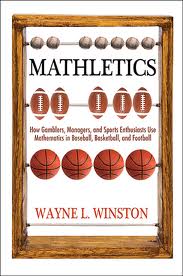Mathletics: How Gamblers, Managers, and Sports Enthusiasts Use Mathematics in Baseball, Basketball, and Football
By Wayne Winston, 2012 edition
I met Wayne in October 2013. I knew that I had one of his books about operations research, but didn’t know much about him. After meeting with him and doing a little research on my own, I’ve learned that he has written an infinite number of books and that he is very skilled at Excel and at sports analytics (among many other things). This book gives intuitive ways to model sports questions and perform analysis with Excel. Example questions include:
-Should we go for the one-point or two-point conversion?
-Should we foul at the end of a basketball game in which we are up 3 points?
-How do different baseball ballparks affect game outcomes?
I’m not a huge fan of analysis in Excel, but Wayne is a wizard at it. I prefer to do a lot of customized number crunching via a programming language (Python/R/Matlab), as opposed to massaging Excel to get what I want. However, this book gave me a lot of ideas for future analysis. It’s kind of a tough read, in that it has 51 chapters over 340 pages and starts/stops thoughts pretty quickly. There are also a lot of editing mistakes in my version, which can sometimes be confusing if you’re not paying attention. I read Mathletics over the span of about 8 months, starting and stopping frequently. I’m glad I finished it, though, because some of the best chapters are in the last part of the book.


